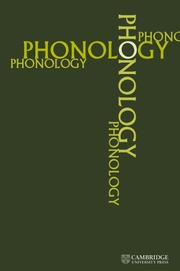Article contents
Illusory vowels in perceptual epenthesis: the role of phonological alternations*
Published online by Cambridge University Press: 15 February 2016
Abstract
Listeners often perceive illusory vowels when presented with consonant sequences that violate phonotactic constraints in their language. Previous research suggests that the phenomenon motivates speech-perception models that incorporate surface phonotactic information and the acoustics of the speech tokens. In this article, inspired by Bayesian models of speech perception, we claim that the listener attempts to identify target phonemic representations during perception. This predicts that the phenomenon of perceptual illusions will be modulated not only by surface phonotactics and the acoustics of the speech tokens, but also by the phonological alternations of a language. We present the results of three experiments (an AX task, an ABX task and an identification task) with native Korean listeners, and native English listeners as a control group, showing that Korean listeners perceive different sets of illusory vowels in different phonological contexts, in accordance with the phonological processes of vowel deletion and palatalisation in the language.
- Type
- Articles
- Information
- Copyright
- Copyright © Cambridge University Press 2016
Footnotes
This article was made possible by the help and support of many individuals. We would like to thank: first and foremost, the associate editor, three anonymous reviewers and the editors for valuable criticism that helped to improve the article greatly; second, Bill Idsardi, Alan Beretta, Yen-Hwei Lin and the members of the phonology-phonetics group at Michigan State University for many helpful discussions; third, Hongjun Seo and Boram Koo for helping us with experiment design; fourth, Alan Munn, Cristina Schmitt and Suzanne Wagner for help with experimental equipment; and finally, the audiences of NELS 43 and the 22nd Japanese/Korean Linguistics Conference for probing questions and helpful discussion.
References
REFERENCES
- 22
- Cited by


